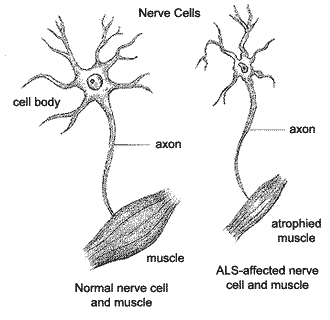Summary of:
Dirren, E., Aebischer, J., Rochat, C., Towne, C., Schneider, B. L., & Aebischer, P. (2015). SOD1 silencing in motoneurons or glia rescues neuromuscular function in ALS mice. Annals of Clinical and Translational Neurology.
Brandon Goldson and Jessica Snyder
What is ALS?:
Also known as Lou Gehrig’s disease, ALS (Amyotrophic lateral sclerosis ) is a fatal and incurable disorder primarily characterized by rapid progressive degeneration of motor neurons in the brain and spinal cord. This degeneration of the motor neurons leads to immobility, paralysis and eventually death 3-5yrs after diagnosis. About 5,000 people are diagnosed with an estimated 30,000 people living with ALS in the United States each year. Though ALS occurs in the world with no racial or socioeconomic boundaries, risk factors include age, sex and genetics. Regarding genetics, 10% of the people suffering from ALS display an inherited form of the disease. Within that population, 20% present a mutation in the gene encoding superoxide dismutase 1(SOD1).

What is the Known Pathophysiology of ALS and SOD1?:
Over 160 mutations of SOD1 have been found to cause ALS. These mutations cause an increase in toxicity and a degeneration of motor neurons in the brain and spinal cord.
What is the Hypothesis?
MiR Sod1 and MiR -b SOD1 effectively silence SOD1 (g93A) activity in mice expressing the human mutated gene. This silencing improves function and delays degeneration and symptoms associated with ALS in mice.
What is the Experimental Design
The effect of a miRNA designed to silence the SOD1 gene was tested both in cell culture and a mice model. Both models contained a SOD1 gene mutation. After the silencing effect was confirmed in vitro, the researchers tested the efficacy of two treatments in SOD1 transgenic mice. The first treatment was AAV6:miR SOD1 and the second was a combination of AAV6:miR SOD1 and AAV9:miR SOD1. In all but the final experiment, the mice were given the treatment soon after birth.
The effect of the treatment in the mouse model was tested in the following ways:
- examine whether or not the AAV is localized in correct cells (motor neurons and astrocytes are test in the spinal cord)
- Observe SOD1 expression with and without the AAV miR treatment
- motor function test of mice with & without treatment (swimming latency test and rotarod test)
- test of proteins contained within muscle sample
- staining of spinal tissue to see motor neurons status (intact or not) as well as the viability of neuromuscular junctions
- muscle fiber thickness to evaluate whether or not muscle atrophy was lessened
- Finally, adult transgenic SOD1 mice were given the treatment and evaluated for viability, motor function and the state of neuronal cells in the spinal cord.
What are the Key Results?:
1: Suppressing of SOD1 in astrocytes and motor neurons : Figure 1
- Quantification of human SOD1 levels relative to miR control confirms that human SOD1 expression is significantly reduced in cells overexpressing miR SOD1 and miR-b SOD1.
2: Delays Disease Progression and Improved Disease Outcome in the following ways
- Increase in intact spinal motor neurons: Figure 4
- NMJ function was rescued to 90% as compared to control G93ASOD1 mic
- Rescues Neuromuscular junctions: Figure 4
- As compared to WT and PBS-injected G93ASOD1 mice, significant preservation of motoneuron integrity at all levels of the spinal cord was observed in AAV6:miR SOD1 and AAV6 + AAV9:miR SOD1 groups.
- Increase in muscle fiber diameter (rescues muscle atrophy): Figure 5
- Hematoxylin and eosin staining of gastrocnemius muscle sections displayed maintenance of muscle integrity with respect to AAV9:miR SOD1 mice compared to control transgenic mice.
What is the Broader context?
These results show promise for the treatment of familial ALS. The maintenance of motor neurons and NMJ is key to attenuating disease symptoms and improving quality of life in ALS patients. Full or partial rescue of neuromuscular function following neonatal and adult ICV infection of AAV-miR SODI may establish the therapeutic silencing approach as an effective treatment for ALS. Furthermore, this paper confirms that SOD1 silencing in specific cell types such as motor neurons and astrocytes is crucial to this therapeutic targeting. Additionally AAV based therapeutic targeting may be used to alter other genes related to ALS prevalence.
P.S. Helpful YouTube Videos about the Nervous System Below!